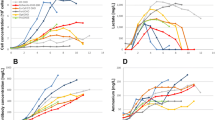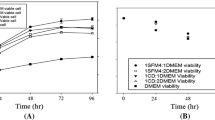Abstract
Serum free fermentation procedures of cell cultures have got a wide application in production of biochemicals. But, cells cultured in serum free media in general are more sensitive to changes in culture condition, especially to nutrient limitation. There are no substances from serum which can support the cells when conditions are changing. In this study special attention is directed to amino acid utilization of mouse hybridoma in batch, chemostat and perfusion fermentations. Detailed data are presented which show the considerable difference of amino acid consumption rates in different fermentation modes. Already, in batch mode there are differences of the two investigated mouse hybridoma cell lines, although they are derived from the same myeloma line. In chemostat running at a dilution rate representing maximal growth rate most of the consumption rates are significant higher than in batch. On the other hand, in perfusion mode the rates are lower than in batch. This indicates clearly the different conditions of the fermentation modes. Therefore, it is necessary to develop serum free processes under the desired production conditions. An accurate analysis of the process is strongly recommended.
Similar content being viewed by others
References
Arwadi MSM and Newsholme EA (1984) Glutamine metabolism in lymphoid tissues. In: Häussinger D, Sies H (eds.) Glutamine Metabolism in Mammalian Tissue (pp. 235–246) Springer.
Birch JR and Hopkins DW (1977) The serine and glycine requirements of cultured human lymphocyte lines. In: Acton RT and Lynn JD (eds.) Cell culture and its applications (pp. 503–511) Academic Press.
Bober H (1986) Über Möglichkeiten der HPLC zur Trennung und Bestimmung von Aminosäuren I. Trennung von Hydrolysatgemischen Beckman Report 1986: 3.
Büntemeyer H (1988) Entwicklung eines Perfusionssystems zur kontinuierlichen Kultivierung tierischer Zellen in Suspension. Ph.D. Thesis, University of Hannover, Germany.
Büntemeyer H, Bödeker BGD and Lehmann J (1987) Membrane-stirrer-reactor for bubble free aeration and perfusion. In: Spier RE and Griffiths JB (eds.) Modern Approaches to Animal Cell Technology (pp. 411–419) Butterworths.
Duval D, Geahel I, Dufau AF and Hache J (1989) Effect of amino acids on the growth and productivity of hybridoma cell cultures. In: Spier RE, Griffiths JB, Stephenne J and Crooy PJ (eds.) Advances in animal cell biology and technology for bioprocesses (pp. 257–259) Butterworths.
Eagle H (1959) Amino acid metabolism in mammalian cell cultures. Science 130: 432–437.
Geaugey V, Duval D, Geahel I, Marc A and Engasser JM (1989) Influence of amino acids on hybridoma cell viability and antibody secretion. Cytotechnology 2: 119–129.
Jäger V, Lehmann J and Friedl P (1988) Serum-free growth medium for the cultivation of a wide spectrum of mammalian cells in stirred bioreactors. Cytotechnology 1: 319–329.
Jockusch BM, Füchtbauer A, Wiegand C, Höner C and Höner B (1986) Probing the cytoskeleton by microinjection. In: Shay JW (ed.) Celland molecular biology of the cytoskeleton (pp. 1–40) Plenum Publishing.
Köhler G and Milstein C (1975) Continuous cultures of fused cells secreting antibody of predefined specifity. Nature 256: 495–497.
Lehmann J, Vorlop J and Büntemeyer H (1988) Bubble free reactors and their development for continuous culture with cell recycle. In: Spier RE and Griffiths JB (eds.) Animal Cell Biotechnology 3 (pp. 221–237) Academic Press.
Pirt SJ (1985) Principles of microbe and cell cultivation (pp. 209–222) Blackwell Scientific Publications.
Takazawa Y, Tokashiki M, Murakami H, Yamada K and Omura H (1988) High-density culture of mouse-human hybridoma in serum-free defined medium. Biotechnol. Bioeng. 31: 168–172.
Wagner R, Ryll T, Krafft H and Lehmann J (1988) Variation of amino acid concentrations in the medium of HU β-IFN and HU IL-2 producing cell lines. Cytotechnology 1: 145–150.
Zielke HR, Sumbilla CM, Zielke CL, Tildon JT and Ozand PT (1984) Glutamine metabolism by cultured mammalian cells. In: Häussinger and Sies H (eds.) Glutamine Metabolism in Mammalian Tissues (pp. 247–254) Springer.
Author information
Authors and Affiliations
Rights and permissions
About this article
Cite this article
Büntemeyer, H., Lütkemeyer, D. & Lehmann, J. Optimization of serum-free fermentation processes for antibody production. Cytotechnology 5, 57–67 (1991). https://doi.org/10.1007/BF00365534
Issue Date:
DOI: https://doi.org/10.1007/BF00365534




